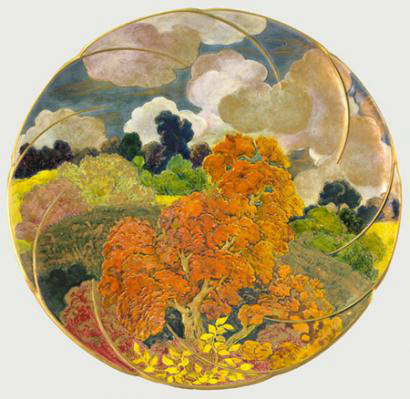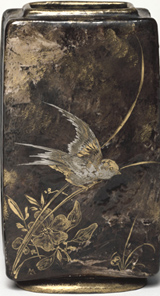
Round plate, Landscape Haviland Manufacture, Auteuil workshop. Decorated by Félix Bracquemond. 1874. Hard-paste porcelain. YLA collection. Collection YLA
|
|
MUSÉE DE LA CÉRAMIQUE
1, rue Faucon ou 94, rue Jeanne d’Arc
76000 ROUEN
INFORMATION:
Tél. 02 35 07 31 74
Websites : www.rouen-musees.com
www.unevillepourlimpressionnisme.fr
OPENING HOURS:
Every day except Tuesdays, from 10 AM to 6 PM.
RATES:
Single ticket for the exhibition and the permanent collections.
Full rate: 5 €. Reduced rate: 3.50 €.
Free for visitors under the age of 26 and the unemployed.
CURATOR:
Audrey Gay-Mazuel
PRESS CONTACTS:
• Virgil Langlade In charge of communication
vlanglade@rouen.fr
• Thomas Fournet Project leader
tfournet@rouen.fr
• Marine Lutz Assistant communication
mlutz@rouen.fr
Tél. 02 35 71 28 40 Fax 02 35 15 43 23

|
This is the only event in the context of the Normandie Impressionniste Festival to focus on decorative arts, and it tries to know what links exist between Impressionist pictorial aesthetics and these works, done between 1872 and the beginning of the XXth century. One could be surprised by seeing the terms «ceramics» and «Impressionism» side by side. How can a ceramic be Impressionist? Is not Impressionism a solely pictorial movement? Some of these pieces, from the last third of the XIXth century, offer a remarkable transposition of the Impressionist pictorial technique and through the glistening colored oxides and the brilliance of the enamel translate the effects of the light and the atmosphere on the subject.
Boosted by Bracquemond
Shortly before Claude Monet created his famous Impression, soleil levant(1872-73, musée Marmottan, Paris), Charles Haviland opened an experimental ceramics workshop in Paris in 1872, on rue d’Auteuil. His concern was to modernize the production of porcelains from the Haviland Manufacture in Limoges, and thus entrusted his Parisian workshop to Félix Bracquemond, an Impressionist printer and painter. It was he who was first influenced by Japanese art in France. He refused to call in professional ceramic artists and turned to painters to produce unique works of art and do real paintings on earthenware decorated with ceramic slip –barbotine-, a decoration technique Ernest Chaplet had perfected at the Laurin Manufacture in Bourg-la-Reine. By using this innovating method of liquid colored clay and applying it to terracotta with a brush, the painter could divide his touch, as on a canvas, in colored impastos.
Flowers and landscapes
The artist thus enjoyed a great freedom of execution to capture the fugitive movement, suggest atmospheric effects, and translate the effects of light on the colors and forms. The favorite motifs on these ceramics - flowers and landscapes - unfold over the whole surface of the pieces that exhibit new and sometimes extravagant shapes, inspired by the ceramics of the Far-East. Urban scenes were the paragon of modernity for the Impressionist painters who turned them into one of their favorite themes. But they are practically absent from the ceramics. Contrary to painters on canvas the painters on ceramics could not work outdoors and for technical reasons were constrained exclusively to their workshops. The palette they used favored browns, ochre and greens and very rarely lit up with the pure blues, pinks and oranges of the Impressionist palette.
A complete panorama
 Vase from a pair of “billet” vases, Swallows
Haviland Manufacture, Auteuil workshop. Charles Midou. Circa 1878. Enamelled terracotta. Musée d'Orsay, Paris. OAO1379-1
PUBLICATION:
The catalogue, directed by Audrey Gay-Mazuel, the curator in charge of the musée de la Céramique in Rouen, groups together five essays by ceramic art historians who give a new definition of «Impressionist» ceramics. Editions Nicolas Chaudun, 192 p., 32 €
|









